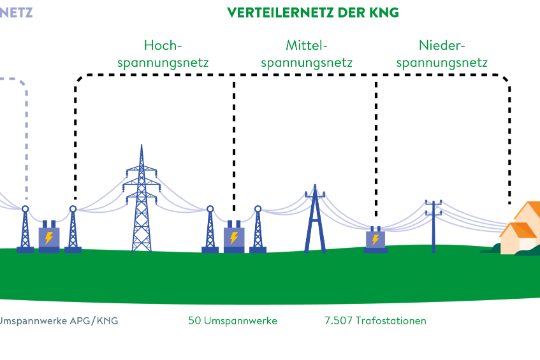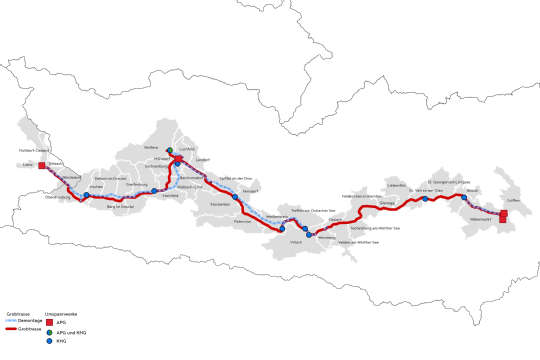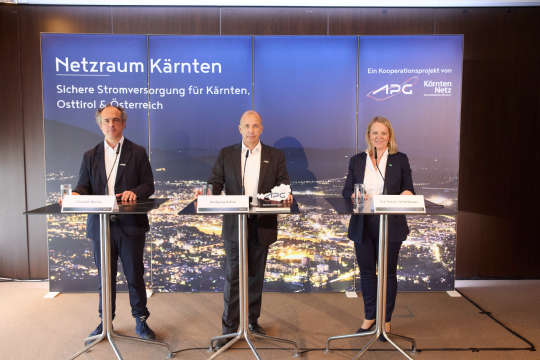Carinthia Grid Area: Rough route presented – detailed planning to be completed by the end of 2026
Austrian Power Grid AG (APG) and Kärnten Netz have presented the rough route for their joint Grid Area Carinthia Project (Netzraum Kärnten). The proposed route spans approximately 190 km, including about 173 km that will be accompanied by a new 110 kV line connecting the Obersielach substation in Carinthia with the Lienz substation in East Tyrol. The route passes through 36 municipalities in total. The presentation of the rough route marks the beginning of a collaborative process with all affected municipalities and residents. Together, they will develop the optimal detailed route for Carinthia, East Tyrol, and Austria by the end of 2026.
The Carinthia Grid Area Project: a once-in-a-century opportunity
Carinthia and East Tyrol require a secure and reliable electricity supply, particularly in light of Austria’s transition from fossil fuels to a sustainable, renewable energy system. The framework for this transformation is ambitious: Austria aims to produce 100 percent of its electricity from renewable sources by 2030 and to achieve climate-neutrality by 2040. Electricity demand in both Carinthia and Austria is expected to double within the next 15 years, driven by the shift of key sectors – industry, transport, and households – from fossil fuels to renewable electricity.
To meet these challenges, the energy industry capacities must be strengthened to facilitate the transport of renewable power from eastern Austria to the pumped storage plants in the south and west. This calls for a robust and future-proof grid-infrastructure. The joint grid expansion and conversion project by APG and Kärnten Netz addresses this need through the construction of a new 380 kV line between Lienz and Obersielach, closing the remaining gap in Austria’s 380 kV ring, and through the expansion of the regional 110 kV distribution grid. This modern, high-capacity grid will lay a crucial foundation for the economic and social development of Carinthia and East Tyrol, while strengthening the energy security and resilience of Austria as a whole.
“By closing the gap in the 380 kV connection between Lienz and Obersielach, we are addressing a major supply gap in Austria’s high-voltage grid,” says Wolfgang Hafner, Project Manager of APG. “This will increase grid stability, eliminate bottlenecks, and strengthen the regional grid in Carinthia and East Tyrol. It will also allow us to efficiently connect renewable energy from the east with storage capacities in the south and west. The Carinthia Grid Area Project is therefore a central component for a secure and affordable energy transition throughout Austria, while also boosting the economy, tourism, and industry, and thus strengthening the entire region.”
“The Carinthia Grid Area Project means redesigning the 110 kV grid in Carinthia,” adds Eva Tatschl-Unterberger, Managing Director of Kärnten Netz. “We are creating the conditions for a secure and sufficient electricity supply for our customers – both now and for decades to come. The new challenges include integrating additional renewable energy generation and accommodating new electrical applications such as electric vehicles, heat pumps, and electrified industrial processes.”
The Carinthia Grid Area Project (Netzraum Kärnten - Austria needs electricity) forms part of APG's current Grid Development Plan, approved by E-Control Austria in 2023, and of the Austrian Grid Infrastructure Plan presented by the federal government in 2024. The new grid infrastructure is scheduled to enter operation in stages starting in 2033.
Following the presentation of the rough route for APG’s 380 kV line, Kärnten Netz has begun the associated planning for the expansion of its 110 kV grid. In cooperation with APG, Kärnten Netz will install the 110 kV line on the same pylons as the 380 kV line, bundling infrastructure and maximizing synergies. “We want to build a high-performance 110 kV connection between Oberdrauburg and Obersielach along the route of the 380 kV line and connect it to the existing 110 kV grid,” explains Tatschl-Unterberger. “This will involve the construction or conversion of eight substations within our 110 kV network. These measures will form part of the Environmental Impact Assessment (EIA) procedure for the Carinthia Grid Area.”
Once the new 110 kV infrastructure is operational, approximately 140 kilometers of existing 110 kV lines and several substations will be dismantled or decommissioned, reducing environmental impact and optimizing grid efficiency.
Planning premises: infrastructure bundling creates synergies
Selecting an optimal route is a complex process that requires close collaboration among experts from many fields. Numerous factors must be considered: in addition to protecting people, nature, and the environment, the route must also be technically feasible, ensuring that both the line and access routes can be constructed and operated safely. Energy efficiency in both transmission and distribution is another key consideration. Economic aspects are equally important — a route must balance technical feasibility, environmental compatibility, and cost efficiency. Each optimization in a project of this scale contributes to sustainable cost relief for the entire grid system. “For us, route planning means bringing together diverse perspectives and areas of expertise to develop the most sustainable solution for everyone,” says Christian Bellina, APG Team Leader and UVE Coordinator. “Austrian Power Grid brings extensive experience from numerous environmental impact assessment procedures to this process.”
The 110 kV line from Kärnten Netz will be carried on the same pylons as APG’s new 380 kV line — an efficient, space-saving, and cost-effective way to build a robust and future-proof grid infrastructure that supports the continued development of Carinthia and East Tyrol as strong economic and living regions. The proposed rough route also takes advantage of existing infrastructure corridors, such as motorways, to maximize infrastructure bundling and minimize environmental impact.
The rough route: 190 km – 36 municipalities – 200 m to 1,000 m corridor width – 3 planning sections from East Tyrol to Lower Carinthia
The route is defined by the substations in Lienz (East Tyrol) and Obersielach near Völkermarkt (Carinthia). Since the start of the year, around 500 km of potential line routes have been examined within the designated corridors. A total of 107 variants across three major route sections were analyzed, compared, and evaluated in detail. The resulting rough route, ranging from 200 meters to 1,000 meters in width, provides the spatial framework for detailed planning. The existing 220 kV lines will remain in place for capacity reasons. Of the 58 municipalities initially considered, 36 remain part of the project — four in East Tyrol and 32 in Carinthia.
In Upper Carinthia, the route follows the Drau Valley, which offers the safest conditions in terms of natural hazards and provides the most suitable solution from technical, economic, and energy perspectives.
In the Spittal to Treffen area, three corridor options were examined. Studies showed that the southern route near Spittal an der Drau, combined with infrastructure bundling along the motorway, is the most compatible solution, best balancing distance from settlements with ecological and technical considerations. This approach also reduces environmental impact and optimizes project costs.
In the Lower Carinthia section, three variants — North, Central, and South — were compared. Experts determined that the southern route via Landskron and the Ossiacher Tauern, running south of Feldkirchen and St. Veit toward Brückl and Obersielach, is the most suitable. This route minimizes proximity to residential areas, aligns with wildlife, forestry, and geological criteria, and allows for infrastructure bundling and cost reductions.
The total length of the planned line is approximately 190 kilometers.
Transparent information process – 90,000 households in the planning region invited
The preliminary route was presented this morning to the provincial governments of Carinthia and Tyrol, the parties represented in the Carinthian state parliament, social partners, and the mayors of the affected municipalities. This presentation also marks the start of a structured and transparent information process involving municipalities, citizens, landowners, and the general public.
From October 6 to 16, 2025, eight regional information fairs will be held in municipalities along the proposed route. At these events, experts and route planners will be available to provide detailed information and answer questions directly. In the coming days, around 90,000 households in the planning region will receive personal invitations to participate.
- October 6, 4:00 p.m. to 8:00 p.m.: Kolpingsaal Lienz
- October 7, 4–8 p.m.: TREFF.Berg, Berg im Drautal
- October 8, 4–8 p.m.: Stadtsaal Spittal
- October 9, 4–8 p.m.: Community Center Feistritz/Paternion
- October 13, 4–8 p.m.: Congress Center Villach
- October 14, 4–8 p.m.: Feldkirchen Town Hall
- October 15, 4–8 p.m.: Fuchspalast, St. Veit/Glan
- October 16, 4–8 p.m.: Neue Burg in Völkermarkt
Further details and exact addresses of the information events can be found on the project portal www.netzraumkaernten.at. The portal also provides comprehensive information about the project, including an interactive map of the rough route and opportunities for the public to share local knowledge and feedback.
"The planning of the 380 kV and 110 kV lines is being carried out with the utmost care and in close dialogue with the affected communities,” emphasizes Wolfgang Hafner, Project Manager at APG. “Transparency and open communication with the public are crucial to jointly developing a viable and future-proof solution for Carinthia, East Tyrol, and Austria.”
Next step: planning the detailed route
The preliminary route area will now undergo detailed examination in several stages. Experts from 23 disciplines are collecting key data throughout the year — covering aspects such as nature, landscape, geology, and soil conditions. The studies also include geological surveys and the development of concepts for potential access routes to the pylon sites. Personal dialogue with municipal representatives, landowners, and citizens plays an essential role in this phase, ensuring that local knowledge and insights are directly incorporated into the route’s development and optimization.
At the end of this process, the detailed route will be finalized, defining pylon locations and access roads with precision. The goal is to complete this by the end of 2026, through a collaborative process that ensures the route is technically sound, environmentally compatible, and socially acceptable. This step-by-step approach—from rough to detailed route — guarantees that the final alignment harmonizes the needs of people, nature, and technology, forming the basis for the subsequent Environmental Impact Assessment (EIA) procedure.
About Austrian Power Grid (APG)
As independent transmission system operator, Austrian Power Grid (APG) is in charge of ensuring the security of the electricity supply in Austria. With our high-performance and digital electricity infrastructure and the use of state-of-the-art technologies, we integrate renewable energies, thus reducing Austria’s dependence on electricity imports, we are the platform for the electricity market, and we provide access to reasonably priced electricity for Austria’s consumers, thus creating the basis for Austria as a supply-secure and future-oriented industrial and business location and place to live. The APG grid totals a length of about 3,500 km and is operated, maintained, and continuously adapted to the increasing challenges of the electrification of businesses, industry, and society by a team of approximately 1,000 specialists. 67 substations are distributed all over Austria, and the majority are operated remotely from APG’s control center in Vienna. Thanks to our committed employees, Austria had a security of supply of 99.99 percent also in 2024 and thus ranks among the top countries worldwide. Our investments of 630 million euros in 2025 (2024: 440 million euros, 2023: 490 million euros) are a motor for the Austrian economy and a crucial factor in reaching Austria’s climate and energy targets. Until 2034, APG will invest a total of approximately 9 billion euros in grid expansion and renovation projects.
About Kärnten Netz
As the regional distribution network operator, KNG-Kärnten Netz GmbH ensures a secure and reliable energy supply for its customers. Its core responsibilities include the planning, demand-based expansion, operation, and maintenance of the electricity and gas grids, as well as efficient fault management. With around 720 employees, Kärnten Netz operates 50 substations, numerous transformer stations, and manages an electricity network of approximately 18,600 kilometers in length.
Press contact
Wolfgang Gröger
Downloads
-
Presseaussendung | Netzraum Kärnten: Grobtrasse präsentiert, Detailplanungen bis Ende 2026
PDF – 0.276 MB
-
Factsheet: Grobtrasse Netzraum Kärnten
PDF – 0.26 MB
-
Factsheet: Termine Bürger-Infomessen
PDF – 0.455 MB
-
Factsheet zum Projekt Netzraum Kärnten
PDF – 0.152 MB
-
Präsentation der Grobtrasse Netzraum Kärnten - PPT
PDF – 3.751 MB





